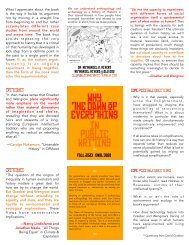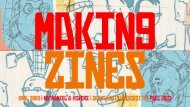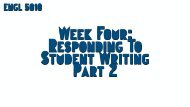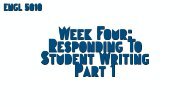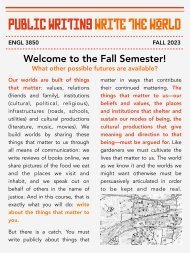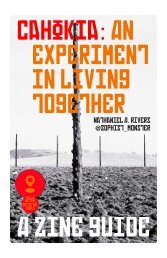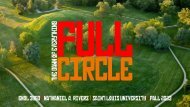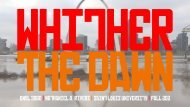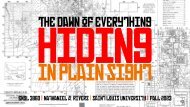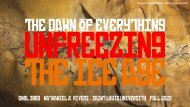ENGL 3860: Introduction Slide Deck
ENGL 3860: Introduction Slide Deck
ENGL 3860: Introduction Slide Deck
You also want an ePaper? Increase the reach of your titles
YUMPU automatically turns print PDFs into web optimized ePapers that Google loves.
Public writing<br />
write the World<br />
<strong>ENGL</strong> <strong>3860</strong> | Nathaniel A. Rivers | saint louis university | fall 2023
People have to have a language to speak<br />
about where they are and what other<br />
possible futures are available to them.<br />
These futures may not be real; if you try to<br />
concretize them immediately, you may find<br />
there is nothing there. But what is there…is<br />
the possibility of being someone else, of<br />
being in some other social space from the<br />
one in which you have already been placed.<br />
Stuart Hall addresses a Campaign for Nuclear<br />
Disarmament (CND) rally in Trafalgar Square in<br />
1958. Photograph: Courtesy Stuart Hall estate / Allen<br />
Stuart Hall | Cultural Studies 1983
Our worlds are built of things that matter: values,<br />
relations (friends and family), institutions (cultural,<br />
political, religious), infrastructures (roads, schools,<br />
utilities) and cultural productions (literature,<br />
music, movies).
Cahokia as it may have appeared c. 1150 CE; painting by Michael Hampshire.<br />
Cahokia was first occupied in AD 700<br />
and flourished for approximately four<br />
centuries (c. 950–1350). It reached a<br />
peak population of as many as<br />
20,000 individuals and was the most<br />
extensive urban centre in prehistoric<br />
America north of Mexico and<br />
the primary centre of the<br />
Middle Mississippian culture. The area<br />
was later named Cahokia (meaning<br />
“Wild Geese”) for a group<br />
of Illinois peoples that inhabited the<br />
area in the 18th century.
The Cahokia Site in its geographic and topographic context with Monk's Mound at center<br />
right.<br />
The Cahokia Site in its geographic and<br />
topographic context with Monk's<br />
Mound at center right. The remains of<br />
the most sophisticated prehistoric<br />
native civilization north of Mexico are<br />
preserved at Cahokia Mounds State<br />
Historic Site. Within the 2,200-acre<br />
tract, located a few miles west of<br />
Collinsville, Illinois, lie the<br />
archaeological remnants of the<br />
central section of the ancient<br />
settlement that is today known as<br />
Cahokia.
After the fire that devastated much of<br />
St. Louis in 1849, city leaders passed<br />
an ordinance requiring all new<br />
buildings to be made of noncombustible<br />
material. That law, along<br />
with the rich clays of eastern Missouri,<br />
led to a flourishing brick industry here.<br />
Historians say that at the industry’s<br />
height, around 1900, the city had<br />
more than 100 manufacturing plants,<br />
and St. Louis became known for the<br />
quality, craftsmanship and abundance<br />
of its brick.<br />
Ruins of the Great Fire of 1849. Daguerreotype by Thomas M. Easterly, 1849. Missouri<br />
Historical Society.
Map of the mines of Cheltenham<br />
(Dogtown) in Saint Louis, MO. This<br />
area of Saint Louis sits atop the<br />
Cheltenham Syncline, which is rich<br />
with clay deposits necessary for the<br />
production of fire brick, which the<br />
city is famous for. The use of such fire<br />
increased after the great fire of 1849,<br />
which prompted city ordinances<br />
requiring the use of fire brick in all<br />
new construction.<br />
Map of the mines of Cheltenham (Dogtown) in St. Louis, MO.
The things that matter to us—our beliefs and values, the places and<br />
institutions that shelter and sustain our modes of being, the cultural<br />
productions that give meaning and direction to that being—must be<br />
argued for. Like gardeners we must cultivate the lives that matter to us.<br />
The world as we know it and the worlds we might want otherwise must<br />
be persuasively articulated in order to be kept and made real. A term<br />
precious to democratic life, republic (res publica), means simply “a public<br />
thing”: a thing held together in common but also over and about which we<br />
argue.
This means that our writing too must be public. No mere<br />
diary entries or talk among aficionados, you must produce<br />
public texts for unfamiliar audiences who might not yet share<br />
your commitment to public parks, accessibility, pop music,<br />
food security, bricks, the environmental and social justice.
Rhetoric<br />
Most generally defined, rhetoric is the use of symbols to produce an<br />
effect (e.g., a verbal command to “Stop,” a red traffic light, or a Journey<br />
song imploring us “Don’t Stop Believing”). From this viewpoint, rhetoric<br />
assumes that the use of language is symbolic action. The famous “word<br />
vs. deeds” distinction has no place here. Though rhetoric has become a<br />
negative word within political circles and contemporary media, it has a rich<br />
history as one of the oldest intellectual pursuits in the western world. With<br />
a focus on audience, context, and identification, rhetoric is a potent<br />
motive force within a community. Successful persuasive practice is a<br />
predicated on an emerging rhetorical understanding of that work.
Advocacy<br />
Though most people associate advocacy and a related term, activism, with<br />
the (radical) fringes of society, this course views any concerted attempt to<br />
shape (change or maintain) the local public environment as advocacy at<br />
its core. Advocacy can include any movement that works for political,<br />
bureaucratic, legal, service-oriented, or attitudinal changes. Note that<br />
advocacy is about actively (re)shaping environments; advocacy is not<br />
reducible to something like “raising awareness.” Awareness is an aspect of<br />
advocacy but never its sole end.
Ethics<br />
Ethics, within the context of rhetorical advocacy, demands integrity, the<br />
inclusion of relevant perspectives, audience identification, thorough<br />
research, and situational awareness. Ethics is about more than following a<br />
static set of protocols; it is about openly engaging others. The Greeks<br />
had a name for this approach to ethics: agonism, or the productive strife of<br />
a public gathering. Rather than producing clear winners and losers,<br />
agonism is about generating a stronger whole. Agonism can be contrasted<br />
with antagonism, which literally means “against the gathering.”
“Drawing on pathbreaking research in archaeology and anthropology,<br />
the authors show how history becomes a far more interesting place<br />
once we learn to throw off our conceptual shackles and perceive<br />
what’s really there. If humans did not spend 95 percent of their<br />
evolutionary past in tiny bands of hunter-gatherers, what were they<br />
doing all that time? If agriculture, and cities, did not mean a plunge<br />
into hierarchy and domination, then what kinds of social and<br />
economic organization did they lead to? The answers are often<br />
unexpected, and suggest that the course of human history may be<br />
less set in stone, and more full of playful, hopeful possibilities, than<br />
we tend to assume.<br />
The Dawn of Everything fundamentally transforms our<br />
understanding of the human past and offers a path toward<br />
imagining new forms of freedom, new ways of organizing society.<br />
This is a monumental book of formidable intellectual range, animated<br />
by curiosity, moral vision, and a faith in the power of direct action.
“A zine is a handmade magazine or mini-comic about anything you<br />
can imagine: favorite bands, personal stories, subcultures, or<br />
collections. They contain diary entries, rants, interviews, and stories.<br />
They can be by one person or many, found in stores, traded at comic<br />
conventions, exchanged with friends, or given away for free. Zines<br />
are not a new idea: they’ve been around for years under various<br />
names (chapbooks, flyers, pamphlets). People with independent<br />
ideas have been getting their word out since before there were<br />
printing presses.<br />
This book is for anyone who wants to create their own zine. It’s for<br />
learning tips and tricks from contributors who have been at the fore<br />
front of the zine movement. It’s for getting inspired to put<br />
thoughts and ideas down on paper. It’s for learning how to design<br />
and print your own zine so you can put it in others’ hands.<br />
Whatcha Mean, What’s a Zine? is for anyone who has something to<br />
say.
Other readings
Things That Matter<br />
For this ongoing project, you produce a series of zines devoted to a thing<br />
that matters to you. The zines are composed for a particular public and will be<br />
released on a regular basis. You have complete creative control over your<br />
productions in terms of medium, style, and content. The only requirement is<br />
that these texts be public and for an audience that needs to be persuaded.<br />
While you are in creative control of your productions, there are a few basic<br />
requirements that all projects must meet. These requirements are largely<br />
procedural, keeping us on track and insuring high quality productions every<br />
three weeks. Basic components include:
Things That Matter<br />
A proposal (1,500 words), which addresses, among other things, the topic to<br />
be taken up and its importance; the technologies to be used in producing the<br />
texts (e.g., word processor, Photoshop, specialty paper, still camera); features<br />
of the texts (specify the kinds of pictures, text, or design elements you will<br />
feature—this section should be fairly fleshed out); the specific and concrete<br />
audience for this production (i.e., freshman smart phone users, vegan foodies,<br />
disabled undergraduates). Additionally, point to two or three specific models<br />
for your project.
Things That Matter<br />
3 tri-weekly productions. Expectations for these productions (i.e., length,<br />
production quality) will be negotiated on an individual basis both during the<br />
proposal stage and throughout the semester.<br />
A touch-point working in concert with your your zine (e.g. stickers, buttons, posters,<br />
mixtapes)<br />
Workshops. During these workshops, students will share drafts of their zines with<br />
the class for feedback and evaluation. Think of these workshops as focus groups.<br />
Following the completion of all productions, you will compose a postmortem<br />
outlining and assessing your productions as a whole. The postmortem will include<br />
both your own assessments as well as any audience feedback.
Zines
Why zines<br />
materializes circulation with its analog rather than digital<br />
form<br />
Zines<br />
foregrounds affective dimensions of writing through its<br />
generic features<br />
invites a multiplicity of compositional modes: writing,<br />
photography, drawing, document design, typography,<br />
paper craft <br />
emphasizes cultural contexts and contents that are<br />
frequently underrepresented
The city itself is less a situs, say Amin<br />
and Thrift, than a certain way of<br />
processing. In fact, it may be more<br />
appropriate to rethink “city” less as a<br />
noun (implying a situs) and more of a<br />
verb, as in to city. We do city, rather<br />
than exist in the city. Amin and Thrift<br />
argue that cities are more about<br />
movements and processes than the<br />
elements that materially construct<br />
their borders.<br />
Edbauer | Rhetorical Ecologies | 11
[I]nvites us to consider the world’s earliest<br />
cities as places of self-conscious social<br />
experimentation, where very different<br />
visions of what a city could be like might<br />
clash—sometimes peacefully, sometimes<br />
erupting in bursts of extraordinary<br />
violence. Increasing the number of people<br />
living in one place may vastly increase the<br />
range of social possibilities, but in no<br />
sense does it predetermine which of<br />
those possibilities will ultimately be<br />
realized.<br />
Graeber and Wengrow | The Dawn of Everything | 326





